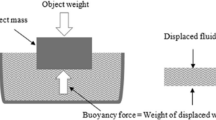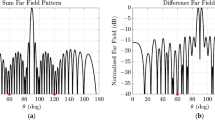Abstract
This paper proposes a gradient-based optimization method for pattern synthesis of phase-only thinned concentric elliptical antenna arrays (CEAAs) with the tangent interpolation function of continuous 0–1 differentiation in topology optimization. The optimization model is reasonably constructed and actualized by simultaneously optimizing the presence or absence of metal materials and the excitation phase within each array element. In order to facilitate solving the optimization problem using the gradient-based algorithms and performing the CEAA pattern synthesis, the tangent interpolation function of metal material with a pseudo-resistance is introduced to realize the continuous 0–1 differentiation of each array element. The design objective is to maximize the difference between the radiation energies of the main-beam direction and the peak sidelobe level with the constraints on the total number of remaining elements. For ensuring that the mutual coupling between the elements is accurately considered, the full-wave method of moments (MoM) is integrated into the optimization method to synthesize the array radiation pattern. Typical examples are provided to verify the effectiveness of the proposed method. Compared with the uniform array and the reference CEAA, the proposed method not only achieves the sidelobe suppression and aperture reduction but also significantly decreases the total number of array elements.





Similar content being viewed by others
References
Amaireh AA, Dib NI, Al-Zoubi AS (2019) The optimal synthesis of concentric elliptical antenna arrays. Int J Electron 107(3):461–479
Aslan Y, Puskely J, Roederer A, Yarovoy A (2019) Phase-only control of peak sidelobe level and pattern nulls using iterative phase perturbations. IEEE Antennas Wirel Propag 18(10):2081–2085
Clavier T, Razavi-Ghods N, Glineur F, González-Ovejero D, Acedo ED, Craeye C, Alexander P (2014) A global-local synthesis approach for large non-regular arrays. IEEE Trans Antennas Propag 62(4):1596–1606
Davidson DB (2010) Computational electromagnetics for RF and microwave engineering. Cambridge University Press, Cambridge
Dawood HS, El-Khobby HA, Abd Elnaby MM, Hussein AH (2022) A new optimized quadrant pyramid antenna array structure for back lobe minimization of uniform planar antenna arrays. Alex Eng J 61(8):5903–5917
Durmus A (2021) The concentric elliptical antenna array patterns synthesis using marine predators algorithm. Arab J Sci Eng 46(10):9485–9495
El-Khamy SE, Eltrass AS, El-Sayed HF (2018) Design of thinned fractal antenna arrays for adaptive beam forming and sidelobe reduction. IET Microw Anatennas Propag 12(3):435–441
El-Khamy SE, Korany NO, Abdelhay MA (2019) Minimising number of perturbed elements in linear and planar adaptive arrays with broad nulls using compressed sensing approach. IET Microw Anatennas Progpag 13(8):1134–1141
Gao RJ, Tang Y, Wang Q, Liu ST (2020) Pattern synthesis considering mutual coupling for peak sidelobe suppression and null controlling via element rotation and phase optimization. Eng Optim 54(1):101–112
Gao RJ, Tang Y, Wang Q, Liu ST (2021) Gradient-based optimization method for interference suppression of linear arrays by the amplitude-only and phase-only control. Int J Microw Wirel Technol 14(8):1002–1008
Gu L, Zhao YW, Zhang ZP, Wu LF, Cai QM, Zhang RR, Hu J (2021) Adaptive learning of probability density taper for large planar array thinning. IEEE Trans Antennas Propag 69(1):155–163
Hamici Z (2019) Fast beamforming with fault-tolerance in massive phased-arrays using intelligent learning control. IEEE Trans Antennas Propag 67(7):4517–4527
Hassan E, Wadbro E, Berggren M (2014) Topology optimization of metallic antennas. IEEE Trans Antennas Propag 62(5):2488–2500
Haupt RL (2015) Adaptively thinned arrays. IEEE Trans Antennas Propag 63(4):1626–1632
Khodier M (2019) Comprehensive study of linear antenna array optimisation using the cuckoo search algorithm. IET Microw Antennas Progpag 13(9):1325–1333
Lema GG, Tesfamariam GT, Mohammed MI (2016) A novel elliptical-cylindrical antenna array for radar applications. IEEE Trans Antennas Propag 64(5):1681–1688
Liu K, Tovar A (2014) An efficient 3D topology optimization code written in Matlab. Struct Multidisc Optim 50(6):1175–1196
Liu ST, Wang Q, Gao RJ (2016) MoM-based topology optimization method for planar metallic antenna design. Acta Mech Sinica-Prc 32(6):1058–1064
Misra B, Mahanti GK, Panda G (2021) Reduction of side lobes in the entire azimuth plane in a planar elliptical array antenna. Int J Commun Syst 35(6):e5067
Mohammed JR (2019) An optimum side-lobe reduction method with weight perturbation. J Comput Electron 18(2):705–711
Paris J, Navarrina F, Colominas I, Casteleiro M (2010) Stress constraints sensitivity analysis in structural topology optimization. Comput Method Appl Mech 199(33–36):2110–2122
Rao SM, Wilton DR, Glisson AW (1982) Electromagnetic scattering by surfaces of arbitrary shape. IEEE Trans Antennas Propag 30(3):409–418
Rocca P, Mailloux RJ, Toso G (2015) GA-based optimization of irregular subarray layouts for wideband phased arrays design. IEEE Antennas Wirel Propag 14:131–134
Rocca P, Anselmi N, Oliveri G, Polo A, Massa A (2021) Antenna array thinning through quantum Fourier transform. IEEE Access 9:124313–124323
Tortorelli DA, Michaleris P (1994) Design sensitivity analysis: overview and review. Inverse Probl Sci Eng 1(1):71–105
Wang Q, Gao RJ, Liu ST (2017) A novel parameterization method for the topology optimization of metallic antenna design. Acta Mech Sinica-Prc 33(6):1040–1050
Wang Q, Xiao H, Yang J, Gao RJ, Liu ST (2020) Mapping-based pattern synthesis of concentric elliptical arrays for sidelode suppression and aperture reduction. IEEE Antennas Wirel Propag 19(12):2206–2210
Wang C, Zhao Z, Zhou M, Sigmund O, Zhang XS (2021) A comprehensive review of educational articles on structural and multidisciplinary optimization. Struct Multidisc Optim 64(5):2827–2880
Wang BJ, Jiang HL, Guo ZF, Yang F, Chen YK, Qu SW, Yang SW (2023) Ultra-wideband dual-polarized tightly coupled dipole array with double layers meta-WAIM. AEU-Int J Electron Commun 159:154492
Wilson RB (1963) A simplicial method for convex programming. PhD. thesis, Harvard University.
Zhou Y, Zhang WH, Zhu JH, Xu Z (2016) Feature-driven topology optimization method with signed distance function. Comput Method Appl Mech 310:1–32
Zhu SH, Yang XS, Wang J, Wang BZ (2020) Miniaturization of patch antenna based on hybrid topology optimization. Int J RF Microw Comput Aided Eng 30(9): e22308
Acknowledgements
This work was supported in part by the National Natural Science Foundation of China (Grant Nos. 12172076), and in part by the Shenzhen Science and Technology Research and Development Fund (JSGG20200102155001779). These financial supports are gratefully acknowledged.
Author information
Authors and Affiliations
Contributions
A. B. and C. wrote the main manuscript text. D. and E. prepared figure 1-5. All authors reviewed the manuscript.
Corresponding author
Ethics declarations
Conflict of interest
The authors declare that they have no conflict of interest.
Replication of results
The results presented in this manuscript are in Fig. 3, Fig. 4, and Fig. 5. The results can be duplicated by implementing the optimization model and simulated process, which the method is presented in this paper. The data of the obtained results through the proposed method can be provided upon request.
Additional information
Responsible Editor: Emilio Silva
Publisher's Note
Springer Nature remains neutral with regard to jurisdictional claims in published maps and institutional affiliations.
Rights and permissions
Springer Nature or its licensor (e.g. a society or other partner) holds exclusive rights to this article under a publishing agreement with the author(s) or other rightsholder(s); author self-archiving of the accepted manuscript version of this article is solely governed by the terms of such publishing agreement and applicable law.
About this article
Cite this article
Tang, Y., Gao, R., Wang, T. et al. Synthesis of phase-only thinned concentric elliptical antenna arrays based on the topology optimization continuous 0–1 differentiation. Struct Multidisc Optim 67, 10 (2024). https://doi.org/10.1007/s00158-023-03722-6
Received:
Revised:
Accepted:
Published:
DOI: https://doi.org/10.1007/s00158-023-03722-6




